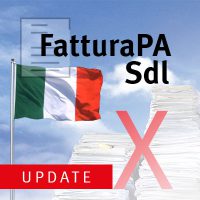Italy: Fattura Electronica News 2020

The Fattura Electronica is an Italian XML based digital invoice format. It is transmitted and received via the Interchange System ‘Sistema di Interscambio’ (SdI). In this blog we discuss the latest news and regulatory changes in relation to Fattura Electronica. Read also the update of June 21, 2021.
Fattura PA & Fattura B2B in Italy
The interchange system ‘Sistema die Interscambio’ (SdI) is nothing more than a ‘virtual postman’ of the Italian Revenue Agency, with the task of receiving, certifying and transmitting files containing electronic invoices.
Electronic invoicing has radically changed the way invoices are filled, sent, received and stored. SEEBURGER started talking about e-Invoicing as early as 2008, when the European Union (EU) invited member states to provide an appropriate regulatory and technological framework in order to digitally manage the entire invoicing and tax control system.
Discover what you should know about e-invoicing in our structured guideline.
Italy, with the aim of reducing tax evasion, has taken a pioneering role in Europe: the obligation of electronic invoicing to Italian public administrations (Fattura PA) began on the 31st of March 2015, while the Budget Law of 2018 has extended the obligation to all private entities (Fattura B2B) since the 1st of January 2019.
Especially electronic invoicing in the B2B sector has forced companies to review their internal processes and those with business partners from a digital perspective. Therefore, it is no longer just a matter of exchanging a simple document using an alternative method, but more so to promote an innovative path that involves the entire life cycle of transactions and that of customer-supplier relations.
SdI is a great success:
Over 2 billion documents have passed successfully through the SdI. Flows were mainly B2B (VAT) and B2C (tax ID numbers), with a minority of B2G (Public Administration).
These figures certify the digital growth of the country, which, driven by fiscal and regulatory levies, has achieved a qualitative and quantitative digital change, bringing benefits to all those involved: customers, suppliers and public administrations. Once the objectives of fiscal sustainability and respect for the environment have been achieved, with the recovery of money from tax evasion and the reduction of paper, the aim is to broaden horizons with new digital challenges for 2020.
2020 – The digitalization process continues
NSO (Order Sorting Node) for the Health Sector
The obligation for the Public Administrations of the National Health System to issue purchase orders for goods in electronic format started on the 1st of February 2020, making them pass through the NSO (Order Sorting Node) platform. NSO in this sense is an affiliated system under the SdI. The obligation will be extended further to purchase orders for services starting on the 1st of January 2021.
The NSO is relevant for all companies, suppliers or any intermediaries operating in the health sector with public companies. The NSO architecture is based on the SdI infrastructure. The different ways in which suppliers and public administrations can exchange electronic order documents via NSO are similar to the well-known transmission channels of the SdI platform, to which the new European Peppol (Pan-European Public Procurement Online) channel has been added.
New XML versions and technical specifications for ‘Sistema di Interscambio’ (SdI)
The 2020 digital change also entails the following three version updates:
- The new version 1.6.1 of the XML format for the B2B channel
- The new version 1.3.1 of the XML format for the B2G channel
- The new version 1.8.1 for the SdI platform
This applies not only to the health sector but also to any customers, suppliers and public administrations using the Interchange System SdI.
It is a complete re-styling of the electronic invoice starting as of 1st October 2020, on the basis of the executive order no.166579/2020, published on 20th of April, on the Agency’s website amending the previous one measure No 99922/2020 of 28 February 2020, because of Covid emergency, whereas the new provisions are planned to be mandatory from 1st of January 2021 onwards. The period between 1st October 2020 and 31st December 2020 is a transitional period, which allows everyone to adapt to the new technical rules and to pass to the new XML tracks, which will make the accounting process for invoices faster and more precise.
In details, the technical specification changes essentially affect four fields of the XML track:
- Document Type (TD)
- Nature Code (N)
- Restraint Type (RT)
- Tax Stamp Amount (Tax Stamp Data)
The plan is to add 8 new types to the ‘Document Type field in order to identify certain accounting transactions more easily.
- TD13 and TD14: Transmission of invoice integration documents of intra-EU and internal reverse charge to the Interchange System.
- TD15 and TD16: Transmission of self-billed invoices for self-consumption and for free transfers to the Interchange System.
- TD17 and TD18: Transmission of documents for the extraction of goods from a VAT tax deposit, with or without payment, to the Interchange System.
- TD19: Communication of supply of goods depreciating and for internal passages.
- TD21: Self-invoicing for the purchase of non-EU services.
The second field change affects the ‘Nature Code’ , that is a coding, prefixed by rule, which serves to catalogue in macro-classes the tax reasons for which an amount shown on the invoice is not subject to VAT. For this field the subdivision of the N3 and N6 codes is foreseen with the aim of a more precise annual VAT declaration, facilitating the pre-filled one.
With regard to the ‘Restraint tax type’ it is proposed to add some new types of social security in addition to the tax types RT01 (restrain tax on physical persons) and RT02 (restrain tax on legal persons). The field has also changed to ‘repeatable’ so that it can be filled in several times on the same invoice.
Finally, for ‘Tax Stamp Data’ the obligation to indicate the amount of the stamp in the document has been removed, because it is pre-set at 2 EUR.
The objective is to optimize and streamline processes in place between the Revenue Agency, taxpayers and economic operators. In fact, with these new changes it will be possible to avoid or eliminate certain requirements such as the ‘esterometro’ regarding the communication of data on cross-border transactions and, more importantly, it will be possible to manage with a single digital mode the entire flow of invoices both domestic and foreign.
SEEBURGER, with its wide experience, can comprehensively support your company in managing its electronic invoicing processes with new Italian regulation compliance.
Our Cloud E-Invoicing solution supports all relevant international standards and acts in accordance with regulations covering 55 countries.
Read Italy’s June 2021 Update: Italy – New archiving rules postponed from June 2021 to January 2022
Thank you for your message
We appreciate your interest in SEEBURGER
Get in contact with us:
Please enter details about your project in the message section so we can direct your inquiry to the right consultant.
Written by: Gerrit Onken
Gerrit Onken has been at SEEBURGER since 2010 as a product manager for software applications and for electronic data exchange services for the business sector. He focuses on solutions for SAP, electronic invoicing (e-invoicing) and innovations for digitalizing business and technical processes for globally-active customers. Originally a banker, Gerrit Onken went on to graduate in business administration, majoring in industrial management and business informatics. After working in the financial sector, he worked as a manager and project manager from 2004 to 2010 for one of the top five corporate consultancies, working with international BPOs in the banking and automotive industries.





